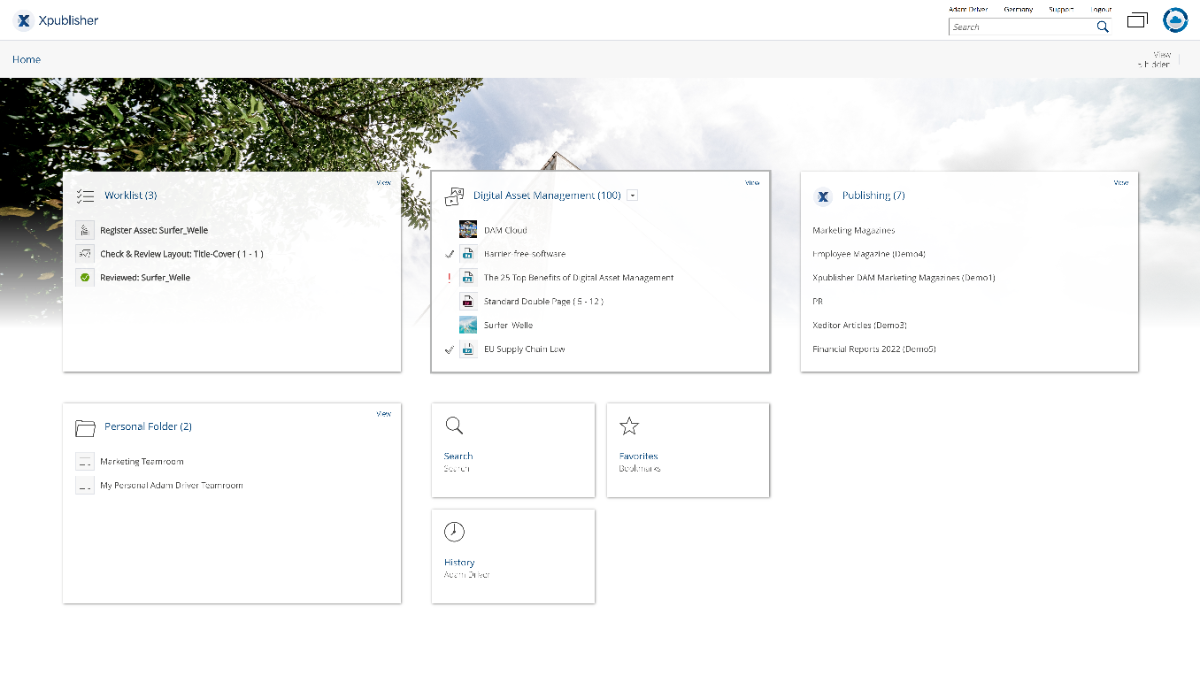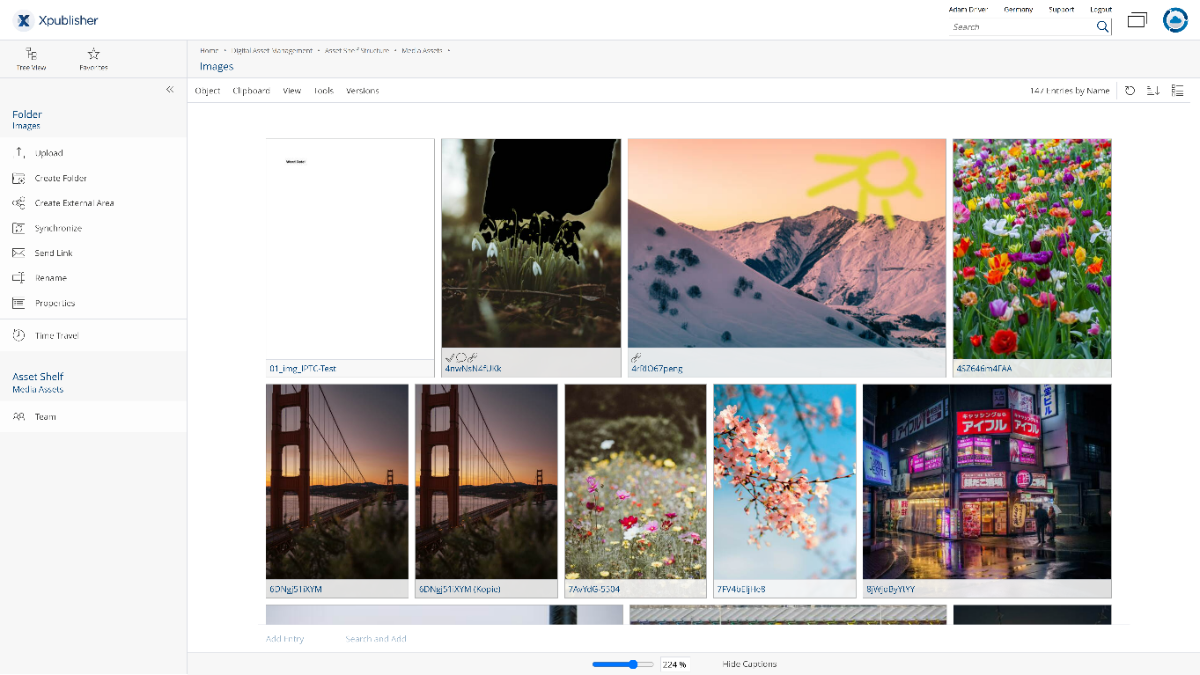Scope of Services – User Perspective
The DAM forms the basis of Xpublisher and is available to all end users. In addition, the publishing solution can be licensed.

The Home Dashboard is the access point to the system for all end users. As soon as a user is granted with the appropriate rights, the widgets for Digital Asset Management respectively Publishing solution are displayed here. If rights are withdrawn from a user, the corresponding widgets are removed.
Digital Asset Management
Clicking on the "Digital Asset Management" widget opens the end user's personal DAM dashboard.

The functionality described below is available to end users.
Use Case | Description |
|---|---|
Asset shelf | Asset shelves are used to manage the digital content and to define the access rights. Folders can be used to sub-structure the asset shelf. |
External area | External areas can be defined in asset shelves. The access rights are taken over from the superordinate asset shelf and can be extended. This makes it easy to collaborate closely, for example, with external graphic design agencies. |
Asset | Assets are types of digital content such as documents, images or videos. In addition to the content, metadata is also stored for the asset. In particular, license information can be stored. |
Registering or re-registering assets | Assets that have not yet been assigned to an asset shelf can be registered to an asset shelf. During the registration, metadata can be defined. Metadata that can be extracted from the asset (e.g. Exif) is automatically taken over. |
Converting assets | You can convert video files to MP4, OGV or WEBM. For audio files, MP3 and OGG are available. The conversion runs in the background. |
Downloading assets | When downloading an asset, the download format needed can be selected. Different download formats can be defined in the DAM configuration that are suitable and allowed for use. |
Tags/Tagging | Tagging is used to index assets. Tags are predefined by administrators. End users can only use existing tags and cannot create new ones. |
Term | Terms also can be used to index assets and are predefined by administrators within the configuration. However, end users are also allowed to create new terms for use themselves. |
Public link | Download formats can also be defined for public links on assets (access without login possible). |
Transfer collection | Transfer collections are used to collect assets from different folders and shelves and make them available as a public link. |
Xeditor | Xeditor enables the users to edit and create structured content directly in the web browser. XML content managed in Digital Asset Management can thus be prepared for the use in products. |

Publishing
Clicking on the corresponding widget opens the end user's personal Publishing dashboard.

The functionality described below is available to end users.
Use Case | Description |
|---|---|
Projects | Projects are based on the publishing configuration, are specified by project types and are used to manage the different products contained within a project. Users can create projects and sub-projects and switch to project view for all projects they have access rights to. Subordinate projects, assigned products, assigned content/assets, external areas, project news and the project history are displayed here. Project settings can be defined, external areas, products and follow-ups can be created and managed. |
Products | Products are the core element in publishing and are used for collaborative planning, creation and generation of publications. They describe the structure of content and consist hierarchically of individual components, layout templates, and assigned assets/content. Their metadata includes name, product type, publication date, issue, and tags. Products can be viewed and edited in the Layout and Structure Plan view. |
Components | A product consists of one or more components. These in turn contain layout templates. |
Layout templates | Layout templates define the representation of the content of products. |
Publications | Products can be published to different formats through various services. |
Content/Assets | Content that can be used and reused in publishing is managed as assets in the DAM. Assets from the DAM can be assigned to both projects and products. This also applies to structured XML content that have been created and edited with the Xeditor. |
External areas | Similar to the DAM, it is likewise possible to work with external areas in the publishing solution. External areas allow collaboration on the basis of individual layouts. For users who are not supposed to have access to the entire product, external areas can be created at product level. |
PDF-preview | A PDF preview of the product, based on the content according to the layout or structure plan, is displayed here. Which means that it can also be an empty PDF document at the beginning. |
Layout plan | The layout plan is used to display, create and edit layout-oriented products. Layout planning enables both the assignment of layout templates and assets/content from the DAM to publications as well as their arrangement. By default, products are displayed in the layout plan when opened. |
Structure plan | The structure plan is used to display, create and edit structure-intensive products by means of a hierarchical tree structure. Structure planning enables both the assignment of layout templates and assets/content from the DAM to publications as well as their arrangement. |
Tags/Tagging | Tagging is used to index objects, meaning not only assets but also projects and products. Tags are predefined by administrators. End users can only use existing tags and cannot create new ones. |
Terms | Terms are also used to index objects, meaning not only assets but also projects and products. They are also managed by administrators in the configuration of the solution. However, end users are allowed to create new terms for use themselves. |